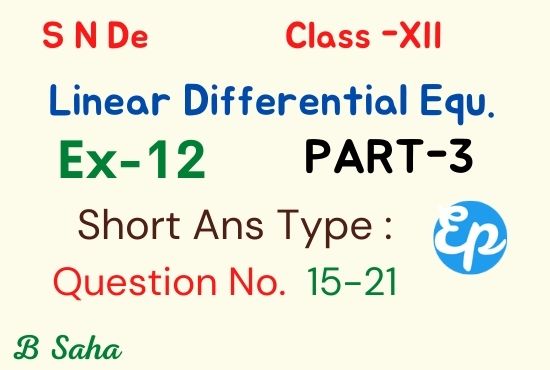$~15.~~\frac{dy}{dx}+\frac{2x}{1+x^2}y=\frac{1}{(1+x^2)^2}$
Sol. $~~~\frac{dy}{dx}+\frac{2x}{1+x^2}y=\frac{1}{(1+x^2)^2} \rightarrow(1)$
The integrating factor(I.F.) of $\,(1)$
$=e^{\displaystyle\int{\frac{2x}{1+x^2}~dx}}\\=e^{\log_e(1+x^2)}\\=1+x^2$
Now, multiplying both sides of $\,(1)\,$ by $\,(1+x^2)\,$ we get,
$~~~(1+x^2)\frac{dy}{dx}+2xy=\frac{1}{1+x^2} \\ \Rightarrow \frac{d}{dx} \{y(1+x^2)\}=\frac{1}{1+x^2} \\ \therefore y(1+x^2)=\displaystyle\int{\frac{1}{1+x^2}~dx} \\ \Rightarrow y(1+x^2)=\tan^{-1}x+c~~\text{(ans.)}$
$~16.~~2\cos x~\frac{dy}{dx}+4y\sin x=\sin2x$
Sol. $~~~2\cos x~\frac{dy}{dx}+4y\sin x=\sin2x \\ \therefore \frac{dy}{dx}+2y\tan x=\frac{\sin2x}{2\cos}\rightarrow(1)$
I.F. of $\,(1)$
$=e^{\int{2\tan x~dx}}\\=e^{2\log_e{\sec x}}\\=e^{\log_e \sec^2x}\\=\sec^2x$
Now, multiplying both sides of $\,(1)\,$ by $~\sec^2x~$ we get,
$~~~~\sec^2x ~\frac{dy}{dx}+2y \tan x\sec^2x=\frac{\sin2x}{2\cos x}\cdot \sec^2x \\ \Rightarrow \frac{d}{dx}(y\sec^2x)=\frac{\sin2x}{2\cos x}\cdot \sec^2x \\ \therefore y\sec^2x=\displaystyle\int{\frac{\sin2x}{2\cos x}\sec^2x~dx} \\ \Rightarrow y\sec^2x=\displaystyle\int{\frac{-d(\cos x)}{\cos^2x}~dx}\\ \Rightarrow y\sec^2x=-\frac{\cos^{-2+1}}{(-2+1)}+c \\ \therefore y\sec^2x=\frac{1}{\cos x}+c \\ \text{or,}~~ y\sec^2x=\sec x+c ~~\text{(ans.)}$
$~17.~~\frac{dy}{dx}+\frac{4x}{x^2+1}y=\frac{1}{(x^2+1)^3}$
Sol. $~~~\frac{dy}{dx}+\frac{4x}{x^2+1}y=\frac{1}{(x^2+1)^3} \rightarrow(1)$
I.F. of $\,(1)$
$=e^{\int{\frac{4x}{x^2+1}}~dx}\\=e^{2\log_e(x^2+1)}\\=e^{\log_e(x^2+1)^2}\\=(x^2+1)^2$
Now, multiplying both sides of $\,(1)\,$ by $~x^2~$ we get,
$~~~(x^2+1)^2~\frac{dy}{dx}+4x(x^2+1)y= \frac{1}{(x^2+1)} \\ \Rightarrow \frac{d}{dx}[y(x^2+1)^2]=\frac{1}{(x^2+1)} \\ \therefore y (x^2+1)^2=\displaystyle\int{\frac{1}{(x^2+1)}~dx} \\ \text{or,}~y(x^2+1)^2=\tan^{-1}x+c~~\text{(ans.)}$
$~18.~~\frac{dy}{dx}+\frac{1}{x \log x}~y=\frac 2x$
Sol. $~~~\frac{dy}{dx}+\frac{1}{x \log x}~y=\frac 2x\rightarrow(1)$
I.F. of $\,(1)$
$=e^{\displaystyle \int{\frac{dx}{x\log x}}}\\=e^{\displaystyle \int{\frac{d(\log x)}{\log x}}}\\=e^{\log(\log x)}\\=\log x$
Now, multiplying both sides of $\,(1)\,$ by $~\log x~$ we get,
$~~\log x ~\frac{dy}{dx}+\frac 1x~y=\frac 2x \log x \\ \text{or,}~~ \frac{d}{dx} (y \log x)=\frac 2x \log x \\ \therefore y \log x=\displaystyle \int{\frac 2x \log x~dx} \\ \text{or,}~~ y \log x=2 \displaystyle \int{\log x~d(\log x)} \\ \text{or,}~~ y \log x=2 \cdot \frac{(\log x)^2}{2}+c \\ \therefore y \log x=(\log x)^2+c~~\text{(ans.)}$
$~19(i)~~~(x^2-1)\frac{dy}{dx}+2xy=\frac{2}{x^2-1}$
Sol. $~~~~(x^2-1)~\frac{dy}{dx}+2xy=\frac{2}{x^2-1}\\ \Rightarrow \frac{dy}{dx}+\frac{2xy}{x^2-1}~y=\frac{y}{(x^2-1)^2} \rightarrow(1)$
I.F. of $\,(1)$
$=e^{\displaystyle\int{\frac{2x}{x^2-1}~dx}}\\=e^{\log_e(x^2-1)}\\=x^2-1$
Now, multiplying both sides of $\,(1)\,$ by $~x^2~$ we get,
$~~(x^2-1)~\frac{dy}{dx}+2xy=\frac{2}{(x^2-1)} \\ \text{or,}~~ \frac{d}{dx}[y(x^2-1)]=\frac{2}{(x^2-1)} \\ \therefore y(x^2-1)=\displaystyle\int{\frac{2}{(x^2-1)}~dx} \\ \text{or,}~~ y(x^2-1)=2 \cdot \frac 12 \log\left(\frac{x-1}{x+1}\right) +c \\ \text{or,}~~ y(x^2-1)=\log \left(\frac{x-1}{x+1}\right)+c~~\text{(ans.)}$
$~19(ii)~~(1+x^2)~\frac{dy}{dx}+2xy=4x^2 ;\\~~~\text{given}~y=0,~~\text{when}~~x=0.$
Sol. $~~(1+x^2)~\frac{dy}{dx}+2xy=4x^2 \\ \Rightarrow \frac{dy}{dx}+\frac{2x}{1+x^2}y=\frac{4x^2}{1+x^2} \rightarrow(1)$
I.F. of $\,(1)$
$=e^{\displaystyle \int{\frac{2x}{1+x^2}}~dx}=e^{\log_e(1+x^2)}=1+x^2$
Now, multiplying both sides of $\,(1)\,$ by $~1+x^2~$ we get,
$~~~(1+x^2)~\frac{dy}{dx}+2xy=4x^2 \\ \text{or,}~~\frac{d}{dx} [y(1+x^)]=4x^2 \\ \therefore y(1+x^2)=\displaystyle \int{4x^2}~dx \\ \text{or,}~~ y(1+x^2)=\frac 43 x^3+c \rightarrow(3)$
Now, $~~y(0)=0 \Rightarrow c=0~~[\text{By (3)}]$
So, putting the value of $~c~$ in $\,(3)\,$ we get,
$~~y(1+x^2)=\frac 43x^3 \\ \Rightarrow 4x^3=3y(1+x^2)~~\text{(ans.)}$
$~20.~~\cos t~ \frac{dx}{dt}+x\sin t=1$
Sol. $~~\cos t~ \frac{dx}{dt}+x\sin t=1 \\ \Rightarrow \frac{dx}{dt}+x\tan t=\sec t\rightarrow(1)$
I.F. of $\,(1)$
$=e^{\displaystyle\int{\tan t}~dx}=e^{\log_e \sec t}=\sec t$
Now, multiplying both sides of $\,(1)\,$ by $~\sec t~$ we get,
$~~~\sec t~\frac{dx}{dt}+x \sec t\tan t=\sec^2t \\ \text{or,}~~ \frac{d}{dt}(x \sec t)=\sec^2t \\ \therefore x\sec t=\displaystyle\int{\sec^2t~dt}\\ \text{or,}~~ t\sec t=\tan t+c \\ \text{or,}~~ x=\sin t+c\cos t~~\text{(ans.)}$
$~21.~~\frac{dy}{dx}+y\sec x=\tan x~~~\left(0 \leq x \leq \frac{\pi}{2}\right)$
Sol. $~~\frac{dy}{dx}+y\sec x=\tan x \rightarrow(1)$
I.F. of $\,(1)$
$=e^{\displaystyle\int{\sec x}~dx}\\=e^{\log_e(\sec x+\tan x)}\\=\sec x+\tan x$
Now, multiplying both sides of $\,(1)\,$ by $~(\sec x+\tan x)~$ we get,
$~~ (\sec x+\tan x)~\frac{dy}{dx}+y\sec x(\sec x+\tan x)\\~~~~=\tan x (\sec x+\tan x) \\ \Rightarrow \frac{d}{dx}[y(\sec x+\tan x)]=\tan x (\sec x+\tan x) \\ \therefore y(\sec x+\tan x)=\displaystyle\int{(\sec x+\tan x)\tan x~dx} \\ \text{or,}~~y (\sec x+\tan x)=\displaystyle\int{\sec x\tan x~dx}\\~~~~~+\displaystyle\int{(\sec^2x-1)~dx}\\~~~~~[\because ~\tan^2x=\sec^2x-1] \\ \text{or,}~~y(\sec x+\tan x)=\sec x+\tan x\\~~~~~~~~~~~~~~~~~~~~~-x+c~~\text{(ans.)}$










Please do not enter any spam link in the comment box